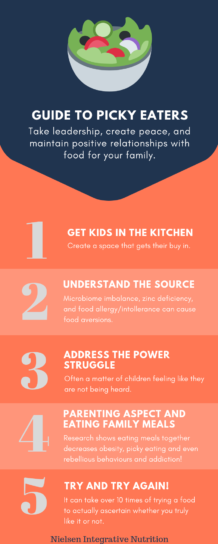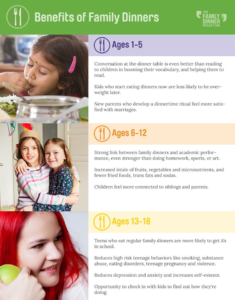Do you have a picky eater in your house or perhaps you struggle to eat foods that you know are good for you? Hang tight-we are going to dive into 5 ways to help overcome picky eating and create peace around the table in your house! We all know Mama (and Dad) could use some peace around here!
Get kids in the kitchen
Getting your kids in the kitchen will help create more responsibility, buy in, and power when it comes to food choices. Even elementary age kids can make their own lunch or snack. If overeating “snacky” foods becomes a problem create a snack box to last the whole week and when those options are gone for the week, they are gone! Click here for a great guide to age appropriate tasks that your kids can do in the kitchen.

TELL THE TRUTH IN LOVE!
Kids will catch on if we deceive them (hiding foods, lying about ingredients …”there aren’t onions in this right?!?!”). They will lose faith in us and in trying foods that are new. Let them know what they’re eating and take it or leave it. This also includes the tiny tastes rule where you can try it and take it or leave it. This does not mean creating separate meals for picky eaters. My pickiest eating clients have consistently reported that after trying a food they didn’t like 8-10x (even spitting it out instead of swallowing it) ultimately changed their taste perceptions and helped them get over their aversions!
Understand the source
Microbial imbalance can cause picky eating as well as digestive distress. Many kids avoid foods and whole food groups because they can’t break that type of food down or have an unknown intolerance/allergy. If you know me at all, you know that the microbiome is my specialty and my passion is helping clients figure out what’s going on in their guts. For more info on the Microbiome you can check out my Microbiome Course or set up a phone call to ask about my 3 Month Gut Healing Program.
Zinc deficiency can also cause an altered taste perception. It is a common deficiency I see with so many of my clients and a dramatic change in taste, preference and digestion is usually the result of my gut healing course.
 Address the power struggle
Address the power struggle
Who loves to take their small children grocery shopping? Before everyone raises their hand (haha, or not!) let me tell you, letting kids pick out one or two new foods in the produce section can create a chance for them to have buy in and excitement around new foods as well as some fun in the store with you. Beyond that if you have the space and time a family garden is a great chance to create some ownership with kids and healthy food. Eating vegetables straight from the garden or getting to try things they picked out at the store themselves can be a lot more fun than simply eating what’s served. It also helps kids get more connected with where their food is coming from which will help them become more mindful adults!
When there are power struggles around food, it’s often a matter of children feeling like they are not being heard. You can give them as much power as possible to create buy in. An example of this would be a snack box for the week stocked with a variety of both treat/cheat foods and nutrient dense options. When the box runs out for the week, the snacks are done for the week.
This book is a great resource on how to talk to kids in a way that helps them understand their power.
Another one of my favorite resources is Ellyn Satter’s Division of responsibility. It’s a great guide to raise a child who is a joy to feed.
Lighten up and enjoy family meals!
Parenting techniques and family meals
There is a strong link between family dinners and academic performance, kids eating healthier, feeling more connected, even substance abuse and violence just to name a few.
Sometimes parents can alter kid’s behavior by being overstrict or hyper-focusing on nutrition and health goals. If you need some clever, practical ways to teach your children food skills this book is a great resource.
Try and Try again
It can take kids and adults over 10 times of trying a food to actually ascertain whether they truly like it or not. This coupled with a changing pallet and taste perception as we age means that we need to introduce and re-introduce food on a regular basis even if our picky eaters have said they don’t like it in the past.

Changing the presentation of the food can also help with getting kids to try it! Check out this example of 6 different ways to present an apple.

photo credit: yourkidstable.com
Here’s to taking leadership, creating peace, and maintaining positive relationships with food for your family!

Finally instigating tiny tastes or allowing kids to spit out food they have aversions to (as long as they try it 3 times) can help the body recognize new textures and flavors as they age!
For more help in this area join our Family Wellness Makeover where you’ll be able to build your ideal family nutrition life by taking small, targeted and actionable steps to health and wellness.






Pingback: How to Build a Better Smoothie – Nielsen Integrative Nutrition LLC